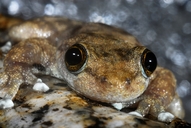|
Litoria lorica Davies & McDonald, 1979
Armoured Mistfrog, Armoured Frog | family: Hylidae subfamily: Pelodryadinae genus: Litoria |
|
Taxonomic Notes: Following the Australian Society of Herpetology, AmphibiaWeb uses Litoria instead of Ranoidea or Dryopsophus (contrary to Dubois and Fretey 2016 and Duellman et al 2016). |
|
 © 2010 Eric Vanderduys (1 of 11) |
|
|
|
Description In life, this frog is gray or gray-brown dorsally and white ventrally, with tiny dark brown spots on the throat (Cogger 2000). It may be uniform or mottled dorsally (Cunningham 2002). The iris is silver to golden (Cunningham 2002). Litoria lorica is a member of the Litoria nannotis group. This frog can be distinguished from L. nannotis (Waterfall Frog), with which it is sympatric, by its smaller size (L. nannotis females measure 46.3-56.0 mm, L. nannotis males 40.1-53.2 mm), a truncate snout, and terminal nares; also, male L. lorica have fewer accessory spines on the head, forearm, and thighs, and less robust forearms than male L. nannotis. It can be distinguished from L. rheocola (Common Mistfrog) and L. nyakalensis (Mountain Mistfrog) by the indistinct tympanum and enlarged prepollex, and the male's pectoral spines (Davies and McDonald 1979). Distribution and Habitat Country distribution from AmphibiaWeb's database: Australia
Litoria lorica is a rainforest specialist endemic to the Wet Tropics Bioregion (Williams and Hero 1998; 2001). As a stream dwelling/stream breeding species (Hero and Fickling 1994) it prefers fast flowing streams in upland rainforest between 640 and 1000 m altitude (McDonald 1992), although it may previously have been present at lower altitudes (M. Cunningham pers. comm.). It has been found on granite boulders in notophyll vine forest in the splash zone near turbulent fast flowing water (Davies and McDonald 1979). Life History, Abundance, Activity, and Special Behaviors This frog is nocturnal; at night the frogs cluster in the splash zone of the cascade, and shelter by day in deep cracks beside the cascade (Hillis, Cunningham and Moritz, pers. obs., cited in Cunningham 2002). The ova are unpigmented (Davies and McDonald 1979), as are the eggs; one clutch with 163 eggs was found, presumably laid in water under rocks in the stream (Cunningham, unpublished). The tadpoles of the species have not been described but are thought to be torrent adapted (dorsoventrally flattened and suctorial) and similar to that of the sympatric species, Litoria nannotis (Davies and McDonald 1979). There is little information available on the species, (as it has only been observed a few times) but ecological similarity to L. nannotis would suggest similar movement patterns generally confined to the stream environment (M. Cunningham pers. comm.). No data are available on population structure or genetic variation of L. lorica (M. Cunningham pers. comm.). The newly discovered Carbine Tableland population is syntopic (shares habitat) with a population of Litoria nannotis. Trends and Threats Disease, such as a viral infection or chytrid fungus, may have contributed to the decline of this species (Berger et al. 1999). Amphibian chytrid fungus is thought to have been responsible for the extinctions of all known high elevation populations of seven Australian frog species in the Wet Tropics between the late 1980s and early 1990s (http://www.jcu.edu.au/top/JCUPRD_037882.html). The newly discovered Carbine Tableland population is infected with chytrid, but the population has been described as "healthy" and individuals are apparently persisting with the chytrid infection (http://www.jcu.edu.au/top/JCUPRD_037882.html). This suggests that either the infection is present at low levels which are not lethal, or that the variant of chytrid present at this site was not lethal, or that this population is resistant to chytrid, perhaps being descendants of frogs which survived an initial chytrid wipe-out. Possible reasons for amphibian decline Disease Comments
References
Berger, L., Speare, R. and Hyatt, A.D. (2000). ''Chytrid fungi and amphibian declines: Overview, implications and future directions.'' Declines and Disappearances of Australian Frogs. A. Campbell, eds., Environmental Australia, Canberra, 21-31. Davies, M. and McDonald, K.R. (1979). ''A new species of stream-dwelling hylid frog from northern Queensland.'' Transactions of the Royal Society of South Australia, 103(7), 169-176. Hero, J-M., Hines, H.B., Meyer, E., Morrison, C., and Streatfeild, C. (1999). ''New records of 'declining' frogs in Queensland (April 1999).'' Frogs in the Community – Proceedings of the Brisbane Conference 13–14 February 1999. R. Natrass, eds., Queensland Museum, Brisbane. Hero, J.-M. and Fickling, S. (1994). A Guide to the Stream-dwelling Frogs of the Wet Tropics Rainforests. James Cook University, Townsville. Hero, J.-M., Hines, H.B., Meyer, E., Morrison, C., Streatfeild, C., and Roberts, L. (1998). ''New records of 'declining' frogs in Queensland, Australia.'' Froglog, 29, 1-4. Ingram, G. J., and McDonald, K. R. (1993). ''An update on the decline of Queensland's frogs.'' Herpetology in Australia: A diverse discipline. D. Lunney and D. Ayers, eds., Transactions of the Royal Zoological Society of New South Wales, 297-303. McDonald, K. and Alford, R. (1999). ''A review of declining frogs in northern Queensland.'' Declines and Disappearances of Australian Frogs. A. Campbell, eds., Environment Australia, Canberra. Available in .pdf format online. McDonald, K.R. (1992). ''Distribution patterns and conservation status of north Queensland rainforest frogs.'' Conservation Technical Report No. 1. Queensland Department of Environment and Heritage, Queensland. Richards, S. J., McDonald, K. R., and Alford, R. A. (1993). ''Declines in populations of Australia's endemic rainforest frogs.'' Pacific Conservation Biology, 1, 66-77. Williams, S. E., and Hero, J. M. (1998). "Rainforest frogs of the Australian wet tropics: Guild classification and the ecological similarity of declining species." Proceedings of the Royal Society of London Series B Biological Sciences, 265(1396), 597-602. Williams, S.E. and Hero, J.-M. (2001). ''Multiple determinants of Australian tropical frog biodiversity.'' Biological Conservation, 98, 1-10. Originally submitted by: Jean-Marc Hero et. al. (first posted 2002-03-15) Edited by: Kellie Whittaker (2008-09-16) Species Account Citation: AmphibiaWeb 2008 Litoria lorica: Armoured Mistfrog <https://amphibiaweb.org/species/1269> University of California, Berkeley, CA, USA. Accessed May 28, 2025.
Feedback or comments about this page.
Citation: AmphibiaWeb. 2025. <https://amphibiaweb.org> University of California, Berkeley, CA, USA. Accessed 28 May 2025. AmphibiaWeb's policy on data use. |



 Map of Life
Map of Life